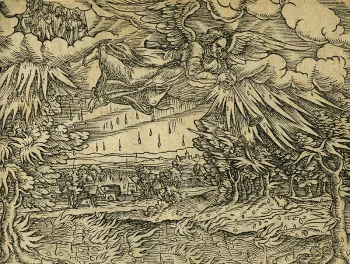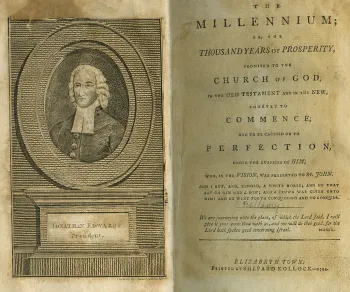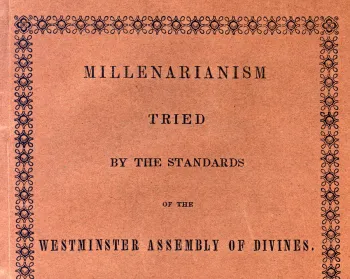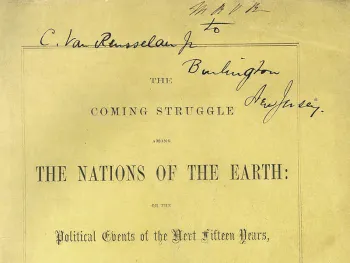Prophecy and End Times in Words and Art
Presbyterians and Eschatology Page 1
Revelation 9:17: "And thus I saw the horses in the vision, and them that sat upon them, having breastplates of fire and of jacinth, and brimstone, and the heads of the horses were as lions; and out of their mouths issued fire and smoke and brimstone."

Eschatology is a branch of theology, philosophy, and futurology concerned with the final events of history, and humanity's ultimate destiny. Christian eschatology is the study of man's destiny as it is revealed in the Bible, extrabiblical prophecies, and various church traditions. Major themes include: death and the afterlife, heaven and hell, the second coming of Jesus, the resurrection of the dead, the rapture, the tribulation, millennialism, the end of the world, the last judgment, and the world to come.
While end times prophecy is not common in Presbyterianism, Presbyterian preachers and authors have focused on eschatological themes at various times in the past. For men like David Austin, John Lillie, and McKendree Robbins Long, eschatology profoundly shaped their beliefs as Christians and Presbyterians. These men promoted eschatological themes in both their words and their art. This exhibit showcases both types of items in the Society's collection.
End Times in Words Page 2
Writings on the Christian end times and debates over eschatology have appeared throughout Presbyterian history.

Interest in biblical eschatology was spurred at the end of the eighteenth century by many who saw the American Revolution as a sign of Christ's return. The Millennium (1794) compiled essays and sermons by American ministers who wrote about the thousand-year reign of peace following the second coming of Jesus Christ. The book includes essays by David Austin (1760-1831), pastor at the First Presbyterian Church in Elizabethtown (now Elizabeth), New Jersey, and Jonathan Edwards, who would later become president of Princeton University.
"It seems no unnatural conclusion from ancient prophecy, and from present appearances, that in order to usher in the dominion of our glorious Immanuel…TWO GREAT REVOLUTIONS are to take place…the first is now taking place; its happy effects we, in this country, already enjoy. O that the Lord would graciously put it into the hearts of his ministers and churches….to begin the second revolution, that which is inward and spiritual."

Rev. Austin persisted in his millennial beliefs, insisting the thousand-year reign of peace would begin on May 15, 1796. Eventually, his congregation petitioned the Presbytery of New York for his removal. The presbytery granted the request in 1797, condemning Austin's beliefs as "delusions of Satan" that "mislead, deceive and destroy the souls of men."



End Times in Art Page 3
Revelation 12:9: "And the great dragon was cast out, that old serpent, called the Devil, and Satan, which deceiveth the whole world: he was cast out into the earth, and his angels were cast out with him."

Millennialism is the conviction that human history will end in a Golden Age. Reverend McKendree Robbins Long (1888-1976), a Presbyterian minister and artist from North Carolina, was influenced by the premillennial fundamentalist ideology that grew in the South in the early 20th century.
Renowned as an evangelist and fiery preacher, Long's artistic talent was as strong as his religious passion. Throughout his life, he created many Biblical drawings and paintings. Later in his career, he illustrated a series of vivid scenes from the Revelation to John, also known as the Book of Revelation. One of the earliest illustrations from that series is "A Horseman from the Vision of the Sixth Angel."

"To the one seated on the throne and to the Lamb be blessing and honor and glory and might forever and ever!" Revelation 5:13.

According to Revelation, the Lamb and his followers are victorious. The Lamb is mentioned 31 times in Revelation alone and is thought to represent Jesus symbolically giving of his life as an atoning sacrifice. The Beast or Dragon, often represents Satan. McKendree Robbins Long portrayed these figures in his art.
"Behold the lamb of God who takes away the sins of the world." John 1:29.

Eschatological passages are found in many places in the Bible, both in the Old and the New Testaments. Reverend Long was also fond of creating illustrated sermon outlines, which he followed when preaching. In the sermon outlines shown here, Long focuses on the Tribulation, Hades, and the Apocalypse of Saint John.


